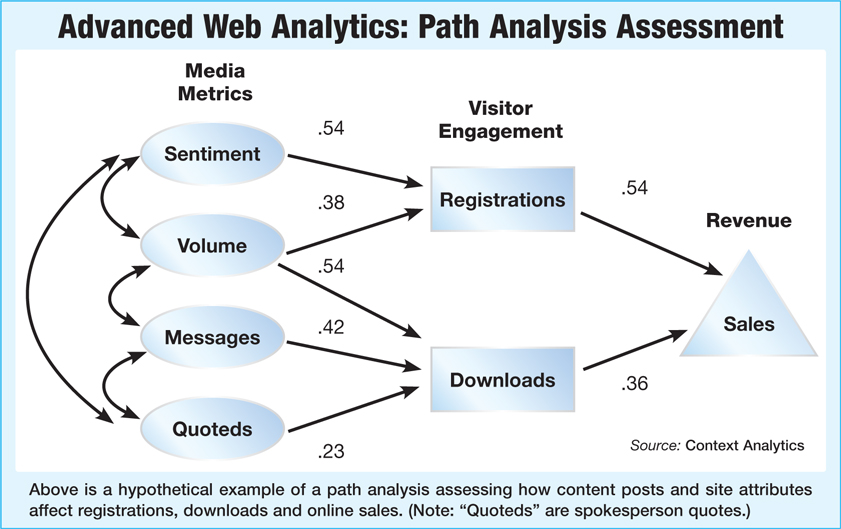Lately there has been much talk of the need for PR executives to focus on business “outcomes” rather than on business “outputs.” The ability to demonstrate how PR drives ROI or sales is indeed measurement’s holy grail.
In prior years, though, the tools needed to prove such outcomes were lacking. But then came Web analytics. Widely used by marketers to optimize online advertising, Web analytics is what drove budget shifts from traditional advertising to very targeted online ad campaigns, as marketers were able to prove their online outcomes.
Where does PR fit into this discussion? For a while, it didn’t, says Seth Duncan, research director at Context Analytics, the research affiliate of PR agency Text 100. “Many PR executives didn’t know that their companies even had Web analytics,” he says. But now, with the buzz around social media and mainstream media’s transition to online, Web analytics is becoming more of a prominent topic in PR, particularly in terms of measuring the value of earned media.
Why should PR be talking about Web analytics? Duncan cites several reasons:
• Web analytics allow PR efforts to be compared to other forms of marketing. For example, using metrics such as traffic and conversion rates, online outputs from both PR and paid advertising, for example, can be analyzed side by side, to see how each drove outcomes.
• New strategies, or shifts in current strategies can be formed, since Web analytics empirically show which types of coverage (both in traditional and social media) help the organization reach its business goals.
• Web analytics are an affordable alternative to more advanced forms of measurement—such as marketing mix modeling (more on advanced analytics later).

BEING BASIC
FICO, a predictive analytics company for the financial services industry, is one organization that measures the value of earned media and makes adjustments accordingly. According to Steve Astle, FICO’s VP of corporate communications, the measurement is a mixture of the traditional—share of voice and prominence—with Web traffic. “We look at the correlations between those two things, and then we can figure out the right media strategy,” says Astle.
As an example of what can be determined, Astle cites some news that his site is planning to release. “It’s not news for an exclusive, but there is a rank ordering of who we would like to see break the story first, and on the most effective Web site,” says Astle. Using Web analytics, he can determine what journalist and online outlet will have the best media impact and the greatest business impact.
MyFICO.com, FICO's site consumer educations site, is a perfect example of what Web analytics can do in terms of earned media measurement, says Duncan. Using basic Web metrics such as unique visitors, number of visits and page views, etc., PR practitioners can address questions such as:
• Which traditional media sites (i.e., sites with print or broadcast companion) and social media sites are driving traffic to an organization’s Web site?
• Which types of sites (e.g., traditional media, blogs, etc.) are driving visitors and engagement at the organization’s Web site?
• How do conversion rates for earned media compare with marketing platforms?
A company that addresses these questions regularly is computer chip maker AMD. Chris James, AMD’s social media strategist, says that experimentation with Web analytics data is key to making interesting correlations. “From matching up two different data sets, you can sometimes—not all the time—find out something very intriguing about your media outreach,” he says.
That experimentation is leading AMD a little closer to the proving of PR outcomes. “We have the PR activity here, the social media activity over there, and they will drive this marketing result,” he says. “We’re getting pretty close to being able to do that.”
GOING ADVANCED
Duncan says that basic Web analytics can be performed by anyone with some Excel experience, but then there’s advanced analytics—a whole different ballgame for PR executives. Advanced analytics involve integrating different types of data, and often conducting advanced statistical analysis on that data. The results, though, can answer much more strategic questions such as:
• To which audiences should we be reaching out to (specific age or income level)?
• Which messages are most effective in driving traffic and engagement?
• Which messages should be matched with specific audiences to optimize communications efforts?
(See accompanying graphic for an example of advanced analytics’ capabilities.)
Astle has been delving into advanced analytics for a couple of years, and the findings have been useful. “One of the nuggets we’ve found is that personal finance reporters don’t influence sales of FICO scores as much as other kinds of writers—there’s a category of media outlet and writer whose referrals work better.” (Astle won’t reveal the category.)
Whether basic or advanced, James has some tips for PR executives looking to upgrade their Web analytics capabilities:
1. You’re only as good as your analyst. People who ask good questions are your best assets.
2. Push the business side to define success. You need to know what you need to prove.
3. You have a wealth of information to pull data from, and to be consistently effective, use all of that information.
Says Astle: “There’s no question this is the way the world is moving. Although you can’t rely solely on Web metrics, it’s a terrific advance and moves the PR profession forward.”
